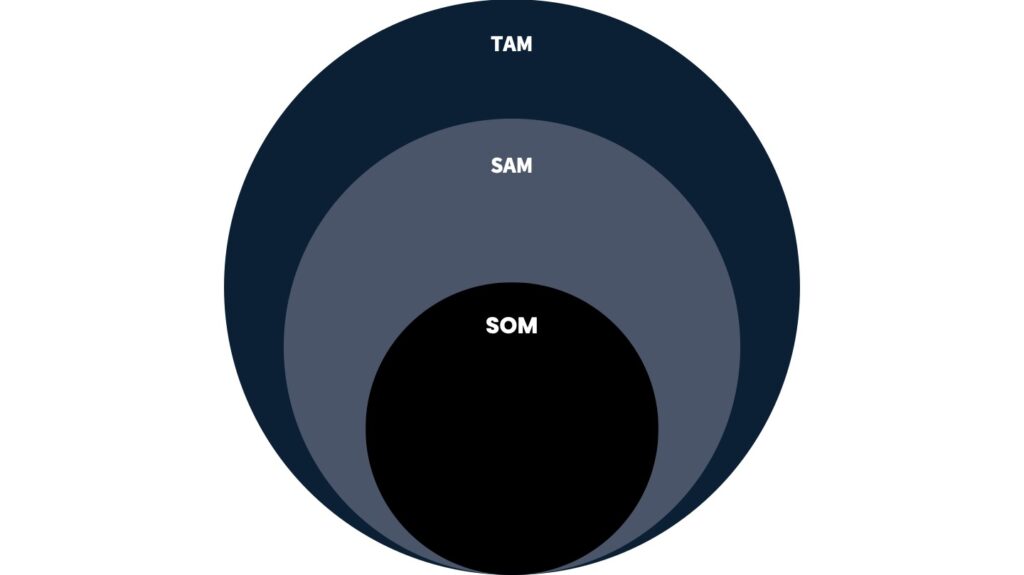In this series, TechNexus provides insights on growth strategies for startups. Follow along with the entire series here.

As a founder, I once considered the obligatory “market sizing” slides in pitch decks to be a bit of a charade. I thought, just show the investors what they want to see—choose a top-down or bottom-up market sizing approach, do some hypothetical consulting exercise to come up with reasonable figures, and focus your real energy on the important aspects of scaling the business. But this mindset was a mistake.
Now, sitting on the venture side of the table, I can see when a founder is just going through the motions of market sizing versus when they REALLY get it—when they truly grasp their market size, the growth opportunity, and how much of the market they can reasonably capture over time. This understanding is critical because, in addition to solving a problem that resonates with consumers, knowing your market size is essential for shaping your growth strategy.
To prove this point, I’m going to break down three key pillars to understanding your market: developing a market size, creating a growth strategy for your market, and forming financial projections based on market penetration.
Definitions
First, let’s define some key venture capital terms to make sure we’re all on the same page. The Serviceable Obtainable Market (SOM) is the market size of your target customer—it’s a subset of your total market that you believe you can capture the most market share in. Next is your Serviceable Available Market (SAM), which includes your target customer plus the most tangential (horizontal or vertical) customer bases you can reasonably expect to capture. Finally, your Total Available Market (TAM) represents the total market value of any customer base that might use your product or service—it’s the maximum possible value if every single potential customer in your market(s) buys your product. For reference, think of the typical three-ring market size diagram below:

Venture investors generally want to see a SOM of at least $100M and a TAM of at least $1B to consider a business venture-backable. Of course, many great businesses may not meet these values, but if you’re seeking venture capital, you should be prepared to prove that your market opportunity meets these minimum benchmarks.
Developing a market size
To truly understand your market potential, I recommend a bottom-up market sizing approach. This method uses your company’s unit economics or revenue model to estimate the market opportunity, making it ideal for startups that have already achieved product-market fit.
Let’s say you own a B2B SaaS startup called “RevBoss,” which provides revenue management software for industrial companies. Assume that RevBoss has found product-market fit with enterprise automotive OEMs in the U.S. You charge $100,000 for each annual contract, and there are 20,000 potential customers in this market.
To calculate your Serviceable Obtainable Market (SOM), multiply the price of your product by the number of potential customers:
- SOM Calculation: $100,000 per contract × 20,000 potential customers = $2 billion.
This $2 billion SOM represents the market size you can realistically target and capture within the automotive OEM sector in the United States. It reflects the immediate opportunity available to your company based on your existing product and customer base.
Growth strategy
When estimating your SAM and TAM, think critically about your expansion plans once you’ve reached a certain level of market penetration in your SOM. For example, does it make more sense to expand vertically into car dealerships or horizontally into aerospace OEMs?
In this scenario, let’s say you decide to expand horizontally into Aerospace, Oil & Gas and Pharma OEMs headquartered in the United States. Each of these sectors represents a new vertical with similar revenue management needs as your existing customers.
- Serviceable Available Market (SAM) Calculation:
- Aerospace OEMs: 5,000 potential customers × $100,000 = $500 million
- Oil & Gas OEMs: 4,000 potential customers × $100,000 = $400 million
- Pharma OEMs: 3,000 potential customers × $100,000 = $300 million
Summing these up, your SAM for the United States would be:
- SAM Total: $2 billion (Automotive) + $500 million (Aerospace) + $400 million (Oil & Gas) + $300 million (Pharma) = $3.2 billion.
Finally, consider your Total Available Market (TAM), which would encompass all OEMs globally. Let’s say you determine there are roughly 3x the U.S. market opportunity for OEMs globally. Citing this research, you might estimate your TAM as:
- TAM Calculation: $3.2 billion (U.S. SAM) × 3 (global expansion) = $9.6 billion.
This $9.6 billion TAM represents the maximum potential market size if you successfully expand your product globally across all relevant OEM sectors.
As you build out your bottom-up market size for these expanded markets, prioritize which customers you’ll target next and for what strategic reasons. For instance, you might focus on Aerospace OEMs first due to their high-value contracts and similar operational needs to your existing automotive clients. Alternatively, you might choose to pursue Oil & Gas OEMs if they offer faster sales cycles or less competition. You will also need to have considered your pricing strategy to properly estimate the expanded market size. Will customers in a tangential market have the same willingness to pay?
Market penetration
Once you’ve developed your financial projections, use your market size to check your expected market penetration. Depending on the results, you may need to adjust either your market size and growth plan or your financial projections. As a general guideline, early-stage companies should aim for less than 5% market penetration of their obtainable market (SOM) and less than 1% of their total market (TAM) over 5 year financial projections.
What I often see in early-stage founders is a tendency to overlook market penetration, leading to overly optimistic financial projections. While optimism is important, projecting $100 million in revenue over five years with a $100 million obtainable market size implies you’ll capture 100% of every possible dollar in your market—an extremely unrealistic scenario. There will always be competition, and market penetration is almost always more challenging than expected. Demonstrating realism and thoughtfulness in market penetration shows discipline and maturity, qualities that bode well for long-term success.
